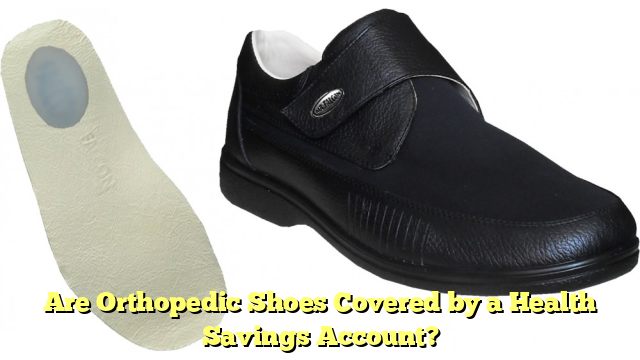Are Orthopedic Shoes Covered by a Health Savings Account?
Are orthopedic shoes covered by a health savings account? If so, then you’re in luck! Your health savings account, also known as FSA, can pay for your orthopedic shoes. Health savings accounts are part of the Medicare Prescription Drug Improvement and Modernization Act, passed by President George W. Bush on December 8, 2003. This legislation was the most comprehensive overhaul of Medicare in history. For this reason, many people are now taking advantage of health savings accounts for orthopedic shoes.
Custom-made orthotics
HSA is a great way to get a prescription for custom-made orthotics. Most orthotics companies will cover the cost of these products. Upstep, for example, sells custom orthotics. They accept both HSA and FSA. HSA dollars never expire, so you can spend them as you wish. If you don’t have a HSA, you can use a Flexible Spending Account, which expires on December 31.
For those without insurance, orthotics are not covered by HSA. But you should check your summary of benefits carefully. While orthotics are considered a type of durable medical equipment, they may not be covered by your health insurance plan. Nevertheless, prescription orthotics are HSA/FSA-eligible. Your insurance company can determine whether you are eligible for coverage. Your doctor will likely prescribe orthotics for your condition.
Besides custom-made orthotics, HSA also covers commercially-available soft foot orthoses. These devices help to absorb shock, improve balance, and relieve pressure on sore spots. They’re usually fabricated to fit the whole foot, from heel to toe. Plastic foam orthotics are available in various densities. They’re most often used for sensitive or ischemic feet. The most common ones are molded from plastic foam.
You should also find out if your employer offers a health care plan that includes custom-made orthotics. Some employers offer health plans that do cover orthotics, but some companies do not. If you’re looking for health coverage, check your plan’s Summary of Benefits and Coverage. If orthotics aren’t covered, contact your insurance company to find out if they cover them. If they don’t, ask if they’ll cover orthotics.
Your HSA may cover custom-made orthotics. Custom-made orthotics are a great way to avoid pain throughout your body. They work by providing constant, gentle pressure to the foot and ankle joints. The orthotics also balance your body weight and reduce pain throughout your entire body. They can be worn in dress shoes, athletic shoes, and athletic shoes. They can help you feel comfortable in all situations. You can also get them for your children if they have problems with their feet.
In addition to HSA coverage, you can also buy custom orthotics for yourself. Custom orthotics may not be covered by Medicare, but if you have a health savings account, your employer may pay for them. Otherwise, you’ll have to find an alternative way to pay for your orthotics. But you should still compare your options and make sure that you’re getting the best coverage. Custom orthotics can be expensive, so it is best to check with your health insurance provider to find a plan that covers them.
Medically necessary inserts
Orthopedic shoe inserts can be reimbursed if they’re medically necessary. To get reimbursed, you’ll need a Letter of Medical Necessity (LMN) from a qualified healthcare provider. Your healthcare provider can assess your condition, measure your feet for sizing, and recommend the right type of footwear for you. Be sure to save your receipt as proof of purchase.
The type of inserts that are covered depends on the condition of the wearer. Some types of orthopedic shoe inserts are considered total contact, multiple densities, removable, and made of the proper material. Orthopedic shoe inserts that support the foot can be either orthotic inserts or metatarsal bars. These orthotics can be made of a variety of materials and styles.
Several modifications to a shoe can qualify as medically necessary. These include rocker soles, adductus positioners, and modified lacers. In some cases, a doctor may recommend molded shoes, which are considered orthopedically necessary. Nonetheless, if your condition requires a modified shoe, you may need a custom orthotic. Aetna covers these modifications as experimental items.
In addition to custom-molded orthotics and shoe modifications, over-the-counter orthotics are also covered as supplies, provided they are medically necessary. However, since these types of shoes must be replaced often, these are not suitable for long-term wear. Children should be evaluated by a doctor before getting any orthotics. You should consult a health care professional before using over-the-counter orthotics for diabetics.
A health reimbursement account (HSA) or flexible spending account (FSA) is another way to obtain reimbursement for orthotics. These accounts work with high-deductible health insurance plans to reimburse qualified medical expenses. HSAs can also help pay for prescription medications. In addition to orthopedic shoe inserts, HSAs can cover diabetic footwear. The reimbursement process for diabetic shoes can be complicated, but your healthcare provider will guide you through the process.
Flexible spending accounts
Using your flexible spending account for orthopedic shoes can be a great way to pay for your new orthotic shoes. First, you’ll need to check that your FSA policy covers orthopedic shoes. Some plans cover only custom-fitted shoes, but that doesn’t mean you can’t use your FSA for orthopedic shoes. You’ll need to make sure you’ve set aside enough money in your account to cover the cost.
Orthopedic shoes may qualify for reimbursement with a health savings account, health reimbursement arrangement, or a flexible spending account. These plans were introduced as part of the Medicare Prescription Drug Improvement and Modernization Act of 2003. It was the largest overhaul of Medicare in the nation’s history. The IRS lists only a partial list of eligible expenses, but orthopedic shoes may qualify. For more information on utilizing health savings accounts for orthopedic shoes, read on.
Some types of orthotic shoes may qualify for an FSA. Custom-made orthotics can provide extra support and cushioning for feet, which can be important for diabetics or athletes. Other procedures a podiatrist may recommend include EPAT (Effective Prosthetic Arthritis Treatment) for heel pain and PinPointe(tm) laser therapy for toenail fungus. A flexible spending account for orthopedic shoes can be an excellent way to pay for foot care.
Most employers offer an FSA program that covers certain medical expenses. Orthotic shoes can also be reimbursed through your FSA if you purchased them with an HRA. However, you’ll need an itemized receipt to receive reimbursement. Fortunately, Upstep makes it easy to receive itemized receipts for your orthopedic shoes, so you can claim more of the money you’ve earned. If you’re eligible for an HSA, the cost of orthotics won’t be much of a hardship.
If you’re planning to use a flexible spending account for orthopedic shoes, make sure you check the rules before making your purchase. Some health savings accounts only reimburse the difference between a prescribed orthopedic shoe and an unspecialized shoe. To maximize your savings, read the rules carefully and submit the claim form before the deadline. Then you’ll be reimbursed for the difference between the two, assuming you’re eligible. This way, you can use your account to pay for orthopedic shoes and get the reimbursement you deserve.
Other items you can purchase with your FSA are shoe inserts, toe cushions, and arch braces. You can also purchase wart removers, callus trimmers, and foot massagers. You’ll have to get a prescription for these items from your doctor before you can spend the money on these essentials. In addition to orthopedic shoes, your FSA will also cover travel essentials like toothbrushes and toothpaste.

